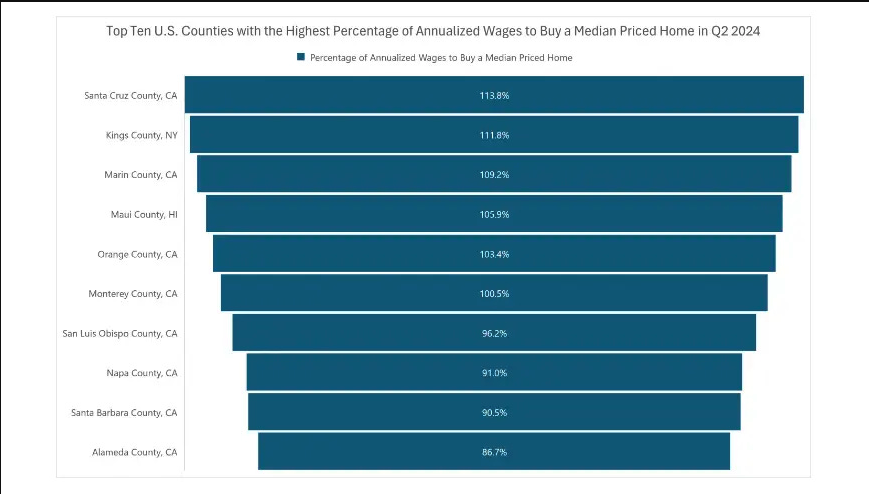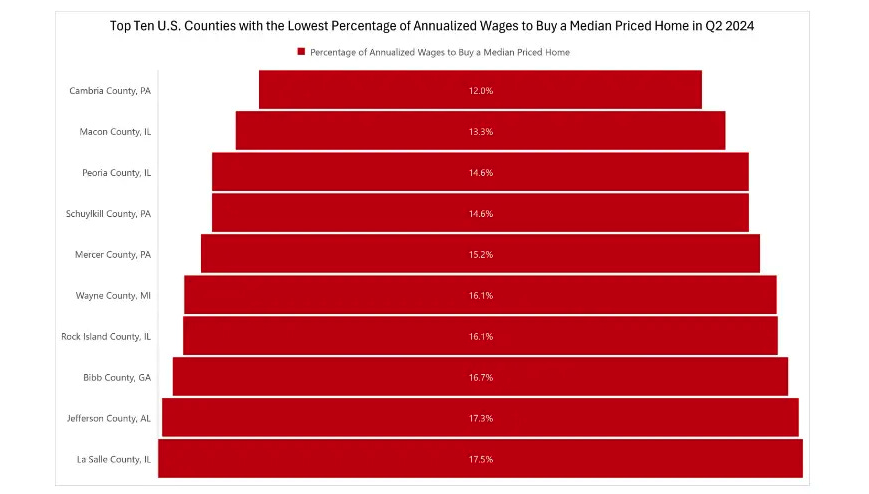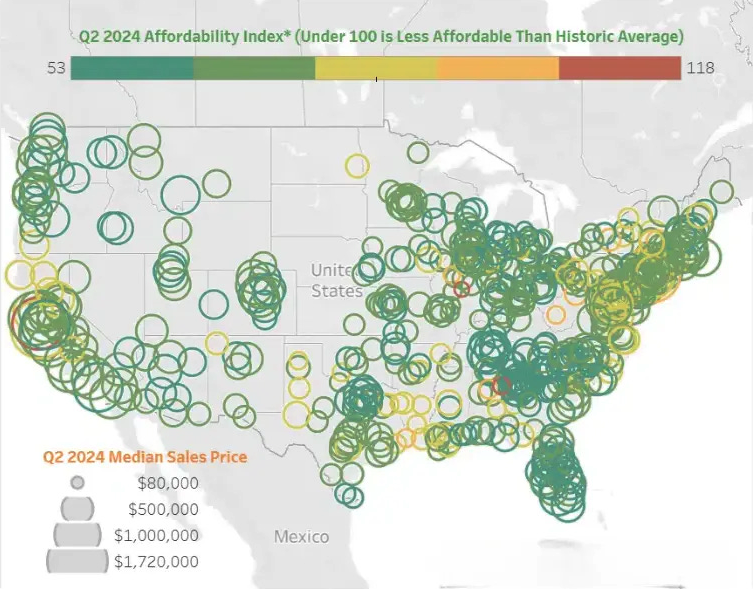Home Affordability Gets Tougher During Second Quarter Across U.S. As Prices Shoot Back Up
Major Home-Ownership Expenses Now Consume 35 Percent of Average Wage Nationwide; Portion Hits High Point in Over a Decade as Median Home Price Soars to Another Record
The second-quarter 2024 U.S. Home Affordability Report showing that median-priced single-family homes and condos remained less affordable in the second quarter of 2024 compared to historical averages in 99 percent of counties around the nation with enough data to analyze. The latest trend continued a pattern, dating back to early 2022, of home ownership requiring historically large portions of wages around the country amid ongoing high residential mortgage rates and elevated home prices.
The report also shows that major expenses on median-priced homes consumed 35.1 percent of the average national wage in the second quarter – marking the high point since 2007 and standing well above the common 28 percent lending guideline.
Both the historic and current measures represented quarterly and annual setbacks following a brief period of improvement from late 2023 into early 2024. The shifts came as the national median home price spiked to a new high of $360,000 during the Spring buying season and mortgage rates remained around 7 percent, leading to increases in the cost of owning a home that outpaced recent increases in wages.
As a result, the portion of average wages nationwide required for typical mortgage payments, property taxes and insurance grew about three percentage points from both the first quarter of this year and the second quarter of last year.
The latest affordability data presents a clear challenge for home buyers. While home prices are increasing and mortgage rates remain relatively high, these factors are making homes less affordable. It’s common for these trends to intensify during the Spring buying season when buyer demand increases. However, the trends this year are particularly challenging for house hunters, more so than at any point since the housing market boom began in 2012. As the 2024 buying season progresses into the Summer, we will continue to monitor the data closely.
The patterns during the months running from April through June came as the national median home price rose 7.3 percent quarterly and 4.7 percent annually. Further hampering buyers during the second quarter were average 30-year home-mortgage rates that ended the quarter at about 6.9 percent, or more than double where they stood in 2021.
Those factors helped boost home ownership expenses by about 10 percent in the second quarter of 2024 after declining slightly in the prior two quarters.
The report determined affordability for average wage earners by calculating the amount of income needed to meet major monthly home ownership expenses — including mortgage payments, property taxes and insurance — on a median-priced single-family home, assuming a 20 percent down payment and a 28 percent maximum “front-end” debt-to-income ratio. That required income was then compared to annualized average weekly wage data from the U.S. Bureau of Labor Statistics.
Compared to historical levels, median home ownership costs in 582 of the 589 counties analyzed in the second quarter of 2024 were less affordable than in the past. That number was up just slightly from 579 of the same counties in the first quarter of this year and from 577 in the second quarter of last year. But it was more than 15 times the figure from early 2021.
Meanwhile, the portion of average local wages consumed by major home-ownership expenses on typical homes was considered unaffordable during the second quarter of 2024 in about 80 percent of the 589 counties in the report, based on the 28 percent guideline. Counties with the largest populations that were unaffordable in the second quarter were Los Angeles County, CA; Cook County (Chicago), IL; Maricopa County (Phoenix), AZ; San Diego County, CA, and Orange County, CA (outside Los Angeles).
The most populous of the 115 counties with affordable levels of major expenses on median-priced homes during the second quarter of 2024 were Harris County (Houston), TX; Wayne County (Detroit), MI; Philadelphia County, PA; Cuyahoga County (Cleveland), OH, and Allegheny County (Pittsburgh), PA.
National median home price jumps quarterly and annually in most markets
The national median price for single-family homes and condos shot up to $360,000 in the second quarter of 2024 – $15,000 more than the previous high of $345,000 hit in the Spring of 2022. The latest figure was up from $335,500 in the first quarter of 2024 and from $344,000 in the second quarter of last year.
At the county level, median home prices rose from the first quarter to the second quarter of this year in 514, or 87.3 percent, of the 589 counties included in the report. Annually, they followed a similar pattern, up in 441, or 74.9 percent of those markets.
Data was analyzed for counties with a population of at least 100,000 and at least 50 single-family home and condo sales in the second quarter of 2024.
Among the 47 counties in the report with a population of at least 1 million, the biggest year-over-year increases in median prices during the second quarter of 2024 were in Orange County, CA (outside Los Angeles) (up 16.2 percent); Alameda County (Oakland), CA (up 12 percent); King County (Seattle), WA (up 11.3 percent); Santa Clara County (San Jose), CA (up 9.8 percent) and Nassau County, NY (outside New York City) (up 8.9 percent).
Counties with a population of at least 1 million where median prices remained down the most from the second quarter of 2023 to the same period this year were Honolulu County, HI (down 3.8 percent); Tarrant County (Forth Worth), TX (down 1.5 percent); Oakland County, MI (outside Detroit) (down 1.4 percent); Hennepin County (Minneapolis), MN (down 1.1 percent) and Fulton County (Atlanta), GA (down 1 percent).
Prices growing faster than wages in half the U.S.
With home values mostly up annually throughout the U.S., year-over-year price changes outpaced changes in weekly annualized wages during the second quarter of 2024 in 293, or 49.7 percent, of the 589 counties analyzed in the report. (Affordability worsened because of that pattern as well as high interest rates and rising property taxes)
The latest group of counties where prices increased more than wages annually included Los Angeles County, CA; Cook County, (Chicago), IL; Maricopa County (Phoenix), AZ; San Diego County, CA, and Orange County, CA (outside Los Angeles).
On the flip side, year-over-year changes in average annualized wages bested price movements during the second quarter of 2024 in 296 of the counties analyzed (50.3 percent). The latest group where wages increased more than prices included Harris County (Houston), TX; Dallas County, TX; Queens County, NY; Tarrant County (Fort Worth), TX, and Bexar County (San Antonio), TX.
Portion of wages needed for home ownership jumps quarterly and annually in most of nation
As home prices soared and interest rates stayed relatively high, the portion of average local wages consumed by major expenses on median-priced, single-family homes and condos went up from the first quarter of 2024 to the second quarter of 2024 in 547, or 92.9 percent, of the 589 counties analyzed. It topped the level from a year earlier in 92.4 percent of those markets.
The typical $2,114 cost of mortgage payments, homeowner insurance, mortgage insurance and property taxes nationwide marked a new high, consuming 35.1 percent of the average annual national wage of $72,358 last quarter. That was up from 31.9 percent in the first quarter of 2024 and from 32.1 percent in the second quarter of last year – far above the recent low point of 21.3 percent hit in the first quarter of 2021.
The latest figure exceeded the 28 percent lending guideline in 474, or 80.5 percent, of the counties analyzed, assuming a 20 percent down payment. That was up from 73.2 percent of the same group of counties in the first quarter of 2024 and 73.5 percent a year ago. It was roughly twice the level recorded in early 2021.
In more than a third of the markets analyzed, major expenses consumed at least 43 percent of average local wages, a benchmark considered seriously unaffordable.
The worst affordability declines generally hit upscale markets concentrated in the West and Northeast with second-quarter median prices of at least $450,000. Those counties already were among the most unaffordable in the U.S.
Among counties with a population of at least 1 million, the largest annual increases in the typical portion of average local wages needed for major ownership expenses were in Orange County, CA (outside Los Angeles) (up from 85.3 percent in the second quarter of 2023 to 103.4 percent in the second quarter of 2024); Alameda County (Oakland), CA (up from 73.3 percent to 86.7 percent); Kings County (Brooklyn), NY (up from 101.3 percent to 111.8 percent); Nassau County, NY (outside New York City) (up from 66.6 percent to 75.7 percent) and Los Angeles County, CA (up from 67.4 percent to 76 percent).
Affordability still toughest along northeast and west coasts
All but one of the top 20 counties where major ownership costs required the largest percentage of average local wages during the second quarter of 2024 were on the northeast or west coasts. The leaders were Santa Cruz County, CA (113.8 percent of annualized local wages needed to buy); Kings County (Brooklyn), NY (111.8 percent); Marin County, CA (outside San Francisco) (109.2 percent); Maui County, HI (105.9 percent) and Orange County, CA (outside Los Angeles) (103.4 percent).
Aside from Kings and Orange counties, those with a population of at least 1 million where major ownership expenses typically consumed more than 28 percent of average local wages in the second quarter of 2024 included Alameda County (Oakland), CA (86.7 percent required); Queens County, NY (78.5 percent) and San Diego County, CA (77.2 percent).
Counties where the smallest portion of average local wages were required to afford the median-priced home during the second quarter of this year were Cambria County, PA (east of Pittsburgh) (12 percent of annualized weekly wages needed to buy a home); Macon County (Decatur), IL (13.3 percent); Peoria County, IL (14.6 percent); Schuylkill County, PA (outside Allentown) (14.6 percent) and Mercer County, PA (north of Pittsburgh) (15.2 percent).
Wage needed to afford typical home 25 percent more than U.S. average
Major home ownership expenses on typical homes sold in the second quarter of 2024 required an annual income of $90,598 to be affordable, which was 25.2 percent more than the latest average national wage of $72,358.
Annual wages of more than $75,000 were needed to pay for major costs on median-priced homes purchased during the second quarter of 2024 in 343, or 58.2 percent, of the 589 markets in the report. That posed major obstacles as average wages exceed that amount in just 11.9 percent of the counties reviewed.
The 20 largest annual wages required to afford typical homes remained on the east or west coasts, led by San Mateo County, CA ($418,928); New York County (Manhattan), NY ($407,393); Santa Clara County (San Jose), CA ($394,999); Marin County, CA (outside San Francisco) ($354,264) and San Francisco County, CA ($339,981).
The lowest annual wages required to afford a median-priced home in the second quarter of 2024 were in Cambria County, PA (east of Pittsburgh) ($20,668); Schuylkill County, PA (outside Allentown) ($27,277); Mercer Count, PA (north of Pittsburgh) ($28,130); Bibb County (Macon), GA ($31,681) and Macon County (Decatur), IL ($31,826).
Virtually every local market around U.S. remains historically less affordable
Among the 589 counties analyzed, 582, or 98.8 percent, were less affordable in the second quarter of 2024 than their historic affordability averages. That was only slightly worse than the 98.3 percent level in the first quarter of 2024 and the 98 percent portion in the second quarter of last year, but 17 times the 5.8 percent figure from the first quarter of 2021. Historical indexes worsened compared to the second quarter of last year in 92.9 percent of those counties, leaving the nationwide index at its lowest point in 17 years.
Counties with a population of at least 1 million that were less affordable than their historic averages (indexes of less than 100 are considered historically less affordable) included Mecklenburg County (Charlotte), NC (index of 59); Fulton County (Atlanta), GA (60); Wake County (Raleigh), NC (62); Franklin County (Columbus), OH (62) and Wayne County (Detroit), MI (63).
Among counties with a population of at least 1 million, those where the affordability indexes worsened most from the second quarter of 2023 to the second quarter of 2024 were Orange County, CA (outside Los Angeles) (index down 17.5 percent); Alameda County (Oakland), CA (15.5 percent); Broward County (Fort Lauderdale), FL (down 12.5 percent); King County (Seattle), WA (down 12.4 percent) and Nassau County, NY (outside New York City) (down 12.1 percent).
Just 1 percent of counties are more affordable than historic averages
Only seven of the 589 counties in the report (1.2 percent) were more affordable than their historic averages in the second quarter of 2024. That was slightly less than the 2 percent level from a year earlier and far worse than the 94.2 percent portion that were historically more affordable in the first quarter of 2021.
Counties that were more affordable in the second quarter of this year compared to historical averages included Macon County (Decatur), IL (index of 117); San Francisco County, CA (105); Ontario County, NY (outside Rochester) (104); Mercer County, PA (north of Pittsburgh) (102) and New York County (Manhattan), NY (102)
Top 10 U.S. Counties Requiring Highest Percentage of Annualized Wages to Buy a Home
Q2 2024 U.S. Home Affordability Report, median-priced single-family homes and condos remained less affordable in the second quarter of 2024 compared to historical averages in 99 percent of counties with sufficient data. This trend, which began in early 2022, indicates that homeownership continues to require historically large portions of wages nationwide due to persistently high residential mortgage rates and elevated home prices.
The latest home affordability analysis also indicates that major expenses on median-priced homes consumed 35.1 percent of the average national wage in the second quarter, the highest level since 2007. This figure significantly exceeds the typical 28 percent lending guideline.
The latest report notes that both the historical and current measures represent quarterly and annual setbacks after a brief period of improvement from late 2023 to early 2024. This shift occurred as the national median home price increased to a new high of $360,000 during the Spring buying season, while mortgage rates remained around 7 percent. These factors led to increases in the cost of homeownership that outpaced recent wage growth.
Q2 2024 home affordability report also indicates that as a result, the portion of average wages nationwide required for typical mortgage payments, property taxes, and insurance grew by approximately three percentage points compared to both the first quarter of this year and the second quarter of last year.
The latest report also found that as home prices soared and interest rates remained relatively high, the portion of average local wages consumed by major expenses on median-priced single-family homes and condos increased from the first quarter to the second quarter of 2024 in 547, or 92.9 percent, of the 589 counties analyzed. This figure also surpassed the level from a year earlier in 92.4 percent of those markets.
Also, according to ’s new analysis the typical $2,114 cost of mortgage payments, homeowner insurance, mortgage insurance, and property taxes nationwide reached a new high, consuming 35.1 percent of the average annual national wage of $72,358 last quarter. This is up from 31.9 percent in the first quarter of 2024 and 32.1 percent in the second quarter of last year, significantly higher than the recent low of 21.3 percent in the first quarter of 2021.
In this post, we dive deep into the data to uncover the list of those top 10 U.S. counties with a population of 100,000 or more and 50 or more sales in Q2 2024 that have the highest percentage of annualized wages required (for typical mortgage payments, property taxes and insurance) to buy a median-priced home with a 30-year fixed-rate mortgage and a 20 percent down payment in Q2 2024. Rounding out that list are: Santa Cruz County, CA (113.8 percent of annualized wages to purchase a median-priced home); Kings County, NY (111.8 percent); Marin County, CA (109.2 percent); Maui County, HI (105.9 percent); and Orange County, CA (103.4 percent), Monterey County, CA (100.5 percent), San Luis Obispo County, CA (96.2 percent), Napa County, CA (91 percent), Santa Barbara County, CA (90.5 percent), and Alameda County, CA (86.7 percent).

Also in this post, we dive deep into the data to uncover the list of those top 10 U.S. counties with a population of 100,000 or more and 50 or more sales in Q2 2024 that have the lowest percentage of annualized wages required (for typical mortgage payments, property taxes and insurance) to buy a median-priced home with a 30-year fixed-rate mortgage and a 20 percent down payment in Q2 2024. Rounding out that list are: Cambria County, PA (12 percent), Macon County, IL (13.3 percent), Peoria County, IL (14.6 percent), Schuylkill County, PA (14.6 percent), Mercer County, PA (15.2 percent), Wayne County, MI (16.1 percent), Rock Island County, IL (16.1 percent), Bibb County, GA (16,7 percent), Jefferson County, AL (17.3 percent), and La Salle County, IL (17.5 percent).

Source: Substack




